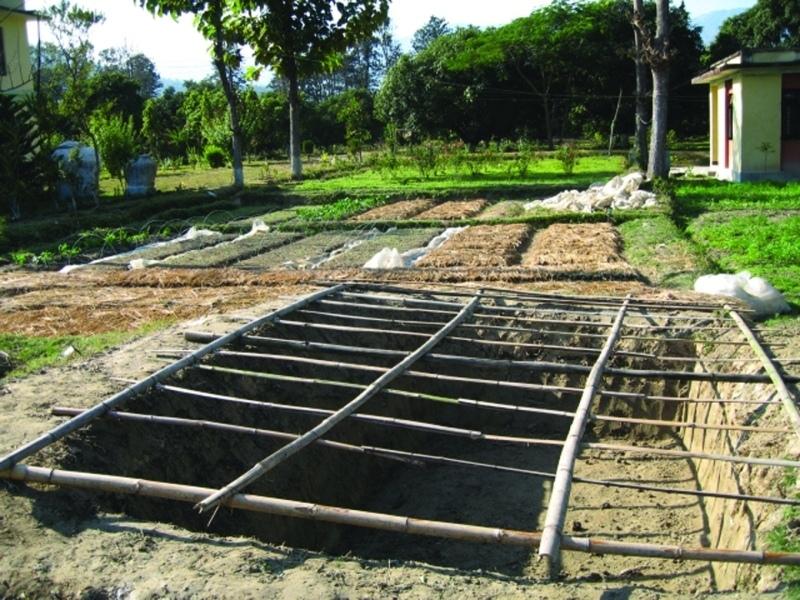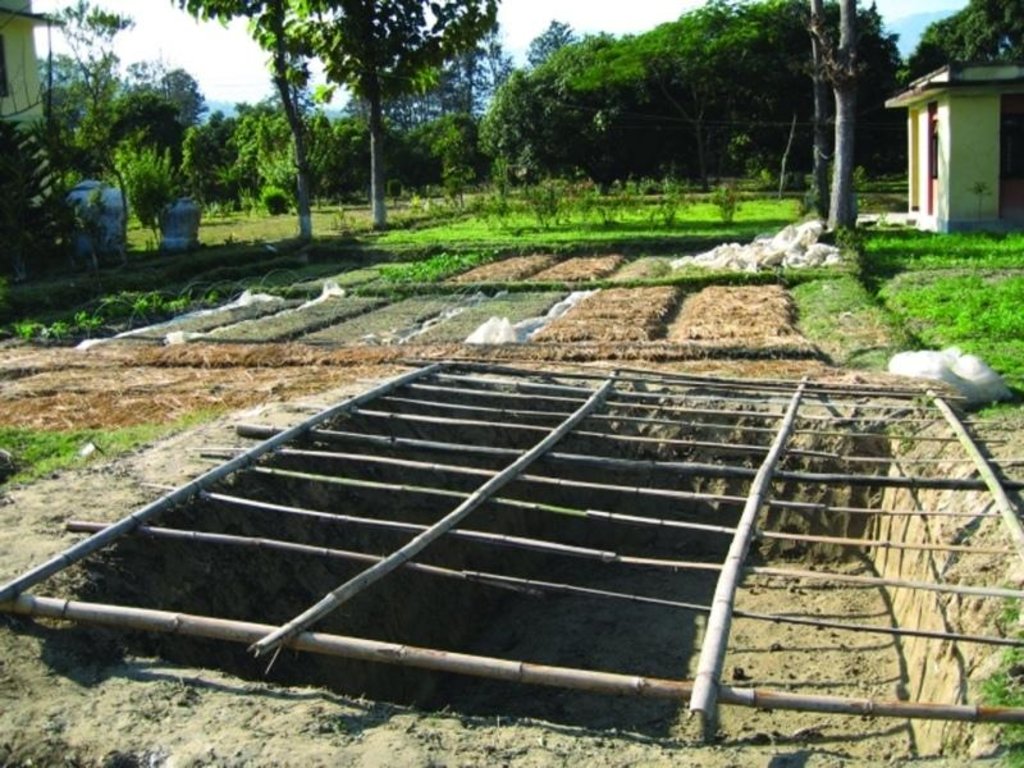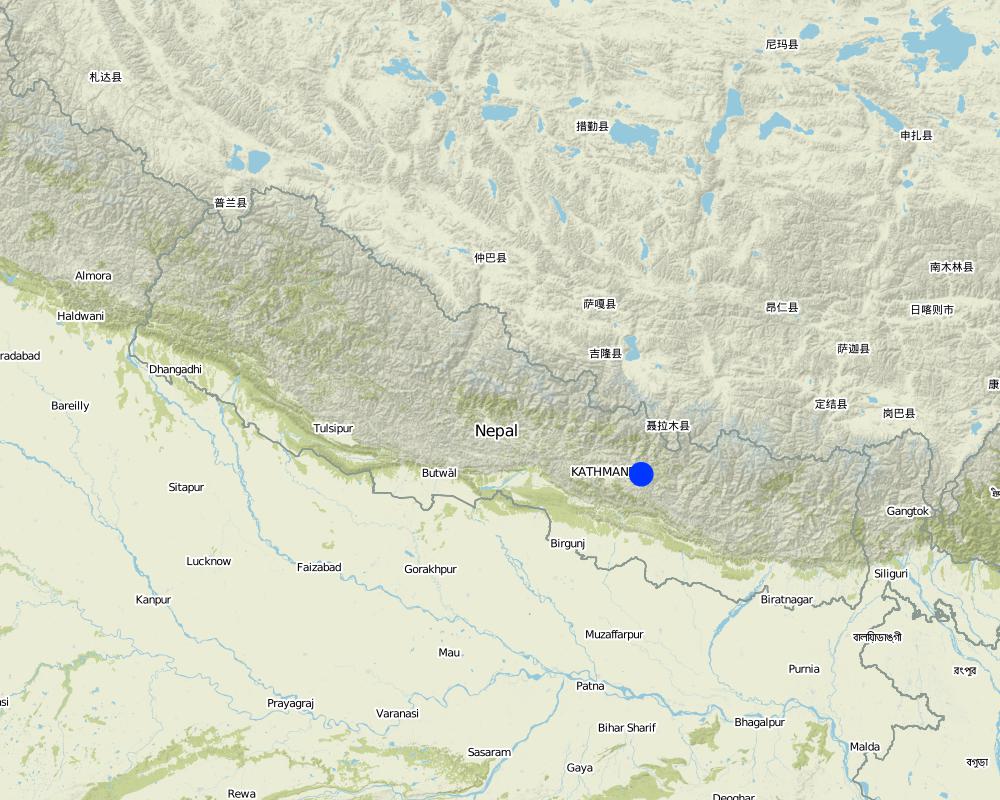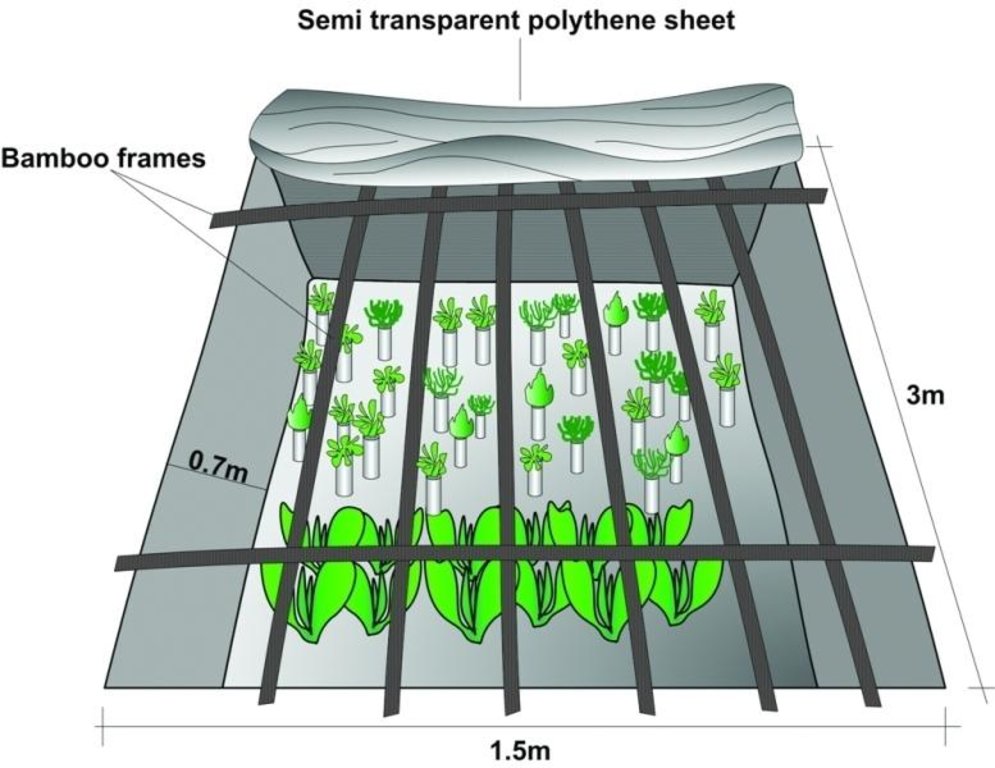Polypit nursery [Nepal]
- Creación:
- Actualización:
- Compilador: Madhav Dhakal
- Editor: –
- Revisores: David Streiff, Alexandra Gavilano
Plastic-Khalte nursery - Nepali
technologies_1498 - Nepal
Visualizar secciones
Expandir todo Colapsar todos1. Información general
1.2 Detalles de contacto de las personas de referencia e instituciones involucradas en la evaluación y la documentación de la Tecnología
Especialista MST:
Especialista MST:
Nombre de la(s) institución(es) que facilitaron la documentación/ evaluación de la Tecnología (si fuera relevante)
ICIMOD International Centre for Integrated Mountain Development (ICIMOD) - Nepal1.3 Condiciones referidas al uso de datos documentados mediante WOCAT
El compilador y la/s persona(s) de referencia claves aceptan las condiciones acerca del uso de los datos documentados mediante WOCAT:
Sí
2. Descripción de la Tecnología MST
2.1 Breve descripción de la Tecnología
Definición de la Tecnología:
A simple, inexpensive and practical method for raising healthy plant seedlings
2.2 Descripción detallada de la Tecnología
Descripción:
During the winter in Nepal’s middle mountains, the soil temperature generally remains at 5-10 degree celsius above the ambient air temperature. This principle was used to design a simple, inexpensive, and effective nursery technology for raising vegetable and horticulture seedlings in colder regions. The polypit technology allows seedlings to be raised by protecting them from the freezing temperatures that occur mostly at night.
Polypits are about 1m deep pits dug into the ground and covered with semitransparent polythene sheets, preferably UV stabilised and supported on bamboo frames. A 30 cm high mud wall is built across the slope on the upper side of the pit. The polythene sheet is sealed on the upper side of the pit, leaving three sides unsealed but held down with stones that can be lifted to access the pit. The base and sides of the polypit are left as they are with no form of plastering.
The polythene sheet covering the pit reduces the photosynthetic photon flux (PPF) by around 30% inside the pit, still allowing sufficient sunlight to reach the plants inside. The polythene is usually removed during the day from 11 am to 4 pm to allow full sunlight to reach the plants except on rainy and very cold days. A modified version of these polypits - only 70 cm deep - were used in the Jhikhu Khola watershed to grow vegetable seedlings during the winter. The pits can be made of any reasonable size depending on the number of seedlings to be grown and the layout of the land. The Jhikhu Khola pits were about 3m long, 1.5m wide, and 0.7m deep.
Since the polypits are closed at night, the CO2 released by the plants and soil microbes accumulates and increases to well above levels outside the pit. In a completely sealed polypit, the CO2 concentration could reach up to 3000 ppm during the night which would be harmful for plants. Thus the polythene cover is only loosely sealed along the edges at night to regulate and maintain the concentration of CO2 at about two to four times the ambient concentration.
The warmer protected conditions and CO2 enrichment leads to extra growth and biomass gain for plants grown inside the pits during the winter. This technology is easy to maintain with the only maintenance costs being to repair damaged polythene sheets and frames.
The polypit technology is useful for mountain farmers where water scarcity and low temperatures limit the potential to raise quality seedlings. The technology is being promoted in the northwest Indian state of Uttarakhand, although only a few farmers have adopted it so far. It is a very promising technology and its use should be encouraged by hill farmers and research and development organisations engaged in raising seedlings. The technology needs more participatory action research to improve it and to encourage more farmers to adopt it spontaneously.
2.3 Fotografías de la Tecnología
2.5 País/ región/ lugares donde la Tecnología fue aplicada y que se hallan comprendidos por esta evaluación
País:
Nepal
Especifique más el lugar :
Kavrepalanchowk district/Jhikhu Khola watershed
Especifique la difusión de la Tecnología:
- aplicada en puntos específicos/ concentrada en un área pequeña
Comentarios:
The technology was tested in the farmers field at Lamdihi and Spice Crop Development Centre. atTamaghat.
Map
×2.6 Fecha de la implementación
Si no se conoce el año preciso, indique la fecha aproximada:
- hace menos de 10 años (recientemente)
2.7 Introducción de la Tecnología
Especifique cómo se introdujo la Tecnología:
- durante experimentos/ investigación
Comentarios (tipo de proyecto, etc.):
The technology is developed by G.B Pant Institute of Himalayan Environment and Development (GBPIHED) in Almora (India) for raising healthy plant saplings, named as polypit (Palni et al. 1994).
3. Clasificación de la Tecnología MST
3.1 Propósito(s) principal(es) de la Tecnología MST
- mejorar la producción
3.2 Tipo(s) actuales de uso de la tierra donde se aplica la Tecnología

Tierras cultivadas
- Cosecha anual
Cosechas anuales - Especifique cultivos:
- cereales - maíz
- leguminosas y legumbres - otros
- cultivos de semillas oleaginosas - girasol, colza, otros
- vegetales - otros
- rice, wheat
Número de temporadas de cultivo por año:
- 3
Especifique:
Longest growing period in days: 150; Longest growing period from month to month: Jun - Oct; Second longest growing period in days: 120; Second longest growing period from month to month: Nov - Feb
Comentarios:
Major land use problems (compiler’s opinion): Production is limited due to insufficient water during winter and the pre-monsoon season (from Nov-May); insufficient
farm income due to small landholdings; increased inputs of chemical fertilisers
Major land use problems (land users’ perception): Irrigation shortage during pre-monsoon and monsoon months.
Type of cropping system and major crops comments: Maize -vegetables/wheat-vegetables
3.4 Provisión de agua
Provisión de agua para la tierra donde se aplica la Tecnología:
- mixta de secano – irrigada
3.5 Grupo MST al que pertenece la Tecnología
- full year planting
3.6 Medidas MST que componen la Tecnología

medidas estructurales
- S4: Acequias niveladas, fosas
4. Especificaciones técnicas, actividades de implementación, insumos y costos
4.1 Dibujo técnico de la Tecnología
Especificaciones técnicas (relacionadas al dibujo técnico):
Poly pit covered with semi transparent plastic sheet which is supported on a bamboo farme.
Technical knowledge required for field staff / advisors: low
Technical knowledge required for land users: low
Main technical functions: protecting seedlings from frost, reduction of water loss, carbon dioxide enrichment
Structural measure: pit
Depth of ditches/pits/dams (m): 0.7m
Width of ditches/pits/dams (m): 1.5 m
Length of ditches/pits/dams (m): 3 m
Construction material (earth): a mud wall is made about 30 cm high from the ground, sloping on the two sides.
Construction material (wood): to place semi transparent plastic on a frame.
Construction material (other): plastic sheet: to cover the pit, rope, wire: frame preparation
Autor:
Madhav Dhakal, A.K. Thaku
4.2 Información general sobre el cálculo de insumos y costos
Especifique cómo se calcularon los costos e insumos:
- por unidad de Tecnología
Especifique unidad:
Polypit nursery
Especifique la moneda usada para calcular costos:
- USD
Indique el costo promedio del salario de trabajo contratado por día:
2.10
4.3 Actividades de establecimiento
| Actividad | Momento (estación) | |
|---|---|---|
| 1. | Determine the appropriate size (length, width and depth) of the pit | beginning of the winter season |
| 2. | Mark the area for soil excavation | beginning of the winter season |
| 3. | Excavate soil from the marked area | beginning of the winter season |
| 4. | Make a mud wall (~30 cm high) from the ground, sloping on two sides | beginning of the winter season |
| 5. | Make a bamboo fram of an appropriate size | beginning of the winter season |
| 6. | Lay the frame over the pit with one end resting on the mud wall | beginning of the winter season |
| 7. | Lay the plastic sheet over the frame | beginning of the winter season |
| 8. | Seal the polythene sheet on the higher side of the mud wall and leave three sides unsealed | beginning of the winter season |
| 9. | Lay the other three sides of the polythene sheet normally at ground level and weigh down with stones that can be removed to access the pit | beginning of the winter season |
| 10. | The base and sidesof the polypit do not need any form of plastering (even with mud) | beginning of the winter season |
4.4 Costos e insumos necesarios para el establecimiento
| Especifique insumo | Unidad | Cantidad | Costos por unidad | Costos totales por insumo | % de los costos cubiertos por los usuarios de las tierras | |
|---|---|---|---|---|---|---|
| Mano de obra | Construction of polypit nursery | Persons/unit | 1,0 | 2,1 | 2,1 | 100,0 |
| Material de construcción | Plastic | unit | 1,0 | 4,0 | 4,0 | |
| Material de construcción | Bamboo | unit | 1,0 | 1,3 | 1,3 | 100,0 |
| Material de construcción | Rope | unit | 1,0 | 0,2 | 0,2 | 100,0 |
| Costos totales para establecer la Tecnología | 7,6 | |||||
| Costos totales para establecer la Tecnología en USD | 7,6 | |||||
Comentarios:
Duration of establishment phase: 4 month(s)
4.5 Actividades de establecimiento/ recurrentes
| Actividad | Momento/ frequencia | |
|---|---|---|
| 1. | The polythene cover is opened to acclimatized the plants to the outside environment | 11:00- 16:00/Every day |
| 2. | Cleaning the pit | After trasplanting the seedlings/ once or twice in |
| 3. | Replacing the frame and polythene sheet if it gets damaged. | before raising nursery/In case of damage |
4.6 Costos e insumos necesarios para actividades de mantenimiento/ recurrentes (por año)
| Especifique insumo | Unidad | Cantidad | Costos por unidad | Costos totales por insumo | % de los costos cubiertos por los usuarios de las tierras | |
|---|---|---|---|---|---|---|
| Mano de obra | Maintaining the pit | Persons/unit | 1,0 | 2,1 | 2,1 | 100,0 |
| Indique los costos totales para mantenecer la Tecnología | 2,1 | |||||
| Costos totales para mantener la Tecnología en USD | 2,1 | |||||
Comentarios:
Machinery/ tools: wooden/iron peg, spade, shovel ,knife, and saw
The cost was calculated only for unit technology , and it can not be extrapolated on hectare basis as in 2006.
4.7 Factores más determinantes que afectan los costos:
Describa los factores más determinantes que afectan los costos:
The plastic sheet , but it is easily affordable by the land users.
5. Entorno natural y humano
5.1 Clima
Lluvia anual
- < 250 mm
- 251-500 mm
- 501-750 mm
- 751-1,000 mm
- 1,001-1,500 mm
- 1,501-2,000 mm
- 2,001-3,000 mm
- 3,001-4,000 mm
- > 4,000 mm
Especifique el promedio anual de lluvia (si lo conoce), en mm:
1200,00
Zona agroclimática
- húmeda
Thermal climate class: subtropics
5.2 Topografía
Pendientes en promedio:
- plana (0-2 %)
- ligera (3-5%)
- moderada (6-10%)
- ondulada (11-15%)
- accidentada (16-30%)
- empinada (31-60%)
- muy empinada (>60%)
Formaciones telúricas:
- meseta/ planicies
- cordilleras
- laderas montañosas
- laderas de cerro
- pies de monte
- fondo del valle
Zona altitudinal:
- 0-100 m s.n.m.
- 101-500 m s.n.m.
- 501-1,000 m s.n.m
- 1,001-1,500 m s.n.m
- 1,501-2,000 m s.n.m
- 2,001-2,500 m s.n.m
- 2,501-3,000 m s.n.m
- 3,001-4,000 m s.n.m
- > 4,000 m s.n.m
Comentarios y especificaciones adicionales sobre topografía :
Altitudinal zone: 850 m a.s.l.
5.3 Suelos
Profundidad promedio del suelo:
- muy superficial (0-20 cm)
- superficial (21-50 cm)
- moderadamente profunda (51-80 cm)
- profunda (81-120 cm)
- muy profunda (>120 cm)
Textura del suelo (capa arable):
- mediana (limosa)
- fina/ pesada (arcilla)
Materia orgánica de capa arable:
- media (1-3%)
Si se halla disponible, adjunte una descripción completa de los suelos o especifique la información disponible, por ej., tipo de suelo, pH/ acidez de suelo, capacidad de intercambio catiónico, nitrógeno, salinidad, etc. :
Soil depth on average: Variable
Soil texture: Fine/ heavy (clay) is red soil with high clay content but medium (loamy, silty) is non red soil
Soil fertility is medium
Soil drainage / infiltration is medium
Soil water storage capacity is medium
5.4 Disponibilidad y calidad de agua
Disponibilidad de aguas superficiales:
pobre/ ninguna
Calidad de agua (sin tratar):
agua potable de mala calidad (requiere tratamiento)
Comentarios y especificaciones adicionales sobre calidad y cantidad de agua:
Water quality (untreated): Also good, but more in rainy season (June- September), less in April/May; source: natural spring.
5.6 Las características de los usuarios de la tierra que aplican la Tecnología
Orientación del mercado del sistema de producción:
- mixta (subsistencia/ comercial)
Ingresos no agrarios:
- 10-50% de todo el ingreso
Nivel relativo de riqueza:
- promedio
Individuos o grupos:
- individual/ doméstico
Nivel de mecanización:
- trabajo manual
- tracción animal
Género:
- hombres
Indique otras características relevantes de los usuarios de las tierras:
Land users applying the Technology are mainly common / average land users
Population density: 200-500 persons/km2
Annual population growth: 2% - 3%
100% of the land users are average wealthy and own 40% of the land.
Off-farm income specification: In most farm households off-farm income plays at least a minor and
increasingly a major role. Occasional opportunities for off-farm income present themselves in the form of daily
labour wages. Some households’ members receive regular salaries whilst an increasing number of Nepalis are
working in India, the Middle East, Malaysia and elsewhere and sending remittance incomes home.
Market orientation of production system: About 50 percent of the product , especially vegetables are grown commercially.
Level of mechanization: Manual labour for planting, irrigation, harvesting; Animals are used for field preparation and in valley bottom machines can be used for field preparation
5.7 Área promedio de la tierra usada por usuarios de tierra que aplican la Tecnología
- < 0.5 ha
- 0.5-1 ha
- 1-2 ha
- 2-5 ha
- 5-15 ha
- 15-50 ha
- 50-100 ha
- 100-500 ha
- 500-1,000 ha
- 1,000-10,000 ha
- > 10,000 ha
¿Esto se considera de pequeña, mediana o gran escala (refiriéndose al contexto local)?
- escala mediana
5.8 Tenencia de tierra, uso de tierra y derechos de uso de agua
Tenencia de tierra:
- individual, con título
Derechos de uso de tierra:
- individual
Derechos de uso de agua:
- comunitarios (organizado)
6. Impactos y comentarios para concluir
6.1 Impactos in situ demostrados por la Tecnología
Impactos socioeconómicos
Producción
manejo de tierras
Comentarios/ especifique:
the pit interrupted land preparation
Ingreso y costos
ingreso agrario
Impactos socioculturales
MST/ conocimiento de la degradación de la tierra
Comentarios/ especifique:
About the polypit and their advantages
Impactos ecológicos
Suelo
humedad del suelo
Comentarios/ especifique:
Inside the polypit high relative humidity is maintained.
Otros impactos ecológicos
Protection of seedlings against frost
Quality of seedlings
Comentarios/ especifique:
customers prefer to buy seedlings grown in polypits compared to those grown outside
6.3 Exposición y sensibilidad de la Tecnología al cambio climático gradual y a extremos relacionados al clima/ desastres (desde la percepción de los usuarios de tierras)
Cambio climático gradual
Cambio climático gradual
| Estación | Incremento o reducción | ¿Cómo es que la tecnología soporta esto? | |
|---|---|---|---|
| temperatura anual | incrementó | bien |
Extremos (desastres) relacionados al clima
Desastres climatológicos:
| ¿Cómo es que la tecnología soporta esto? | |
|---|---|
| tormenta de lluvia local | bien |
| tormenta de viento | bien |
Desastres climatológicos
| ¿Cómo es que la tecnología soporta esto? | |
|---|---|
| sequía | bien |
Desastres hidrológicos
| ¿Cómo es que la tecnología soporta esto? | |
|---|---|
| inundación general (río) | bien |
Otras consecuencias relacionadas al clima
Otras consecuencias relacionadas al clima
| ¿Cómo es que la tecnología soporta esto? | |
|---|---|
| periodo reducido de crecimiento | no se sabe |
6.4 Análisis costo-beneficio
¿Cómo se comparan los beneficios con los costos de establecimiento (desde la perspectiva de los usuarios de tierra)?
Ingresos a corto plazo:
positivo
Ingresos a largo plazo:
muy positivo
¿Cómo se comparan los beneficios con los costos de mantenimiento/ recurrentes (desde la perspectiva de los usuarios de tierra)?
Ingresos a corto plazo:
muy positivo
Ingresos a largo plazo:
muy positivo
Comentarios:
The investment costs can be recouped within one season leading to positive results due to higher production.
6.5 Adopción de la Tecnología
- casos individuales / experimentales
Si tiene la información disponible, cuantifique (número de hogares y/o área cubierta):
2 households
De todos quienes adoptaron la Tecnología, ¿cuántos lo hicieron espontáneamente, por ej. sin recibir nada de incentivos/ materiales:
- 0-10%
Comentarios:
100% of land user families have adopted the Technology with external material support
2 land user families have adopted the Technology with external material support
Comments on acceptance with external material support: survey results
There is no trend towards spontaneous adoption of the Technology
Comments on adoption trend: There were not enough dissemination and awareness raising activities to inform farmers of the benefits of the technology and convince them to use it.
6.7 Fuerzas/ ventajas/ oportunidades de la Tecnología
| Fuerzas/ ventajas/ oportunidades desde la perspectiva del usuario de la tierra |
|---|
|
The survival rate for vegetable seedlings is higher and seedlings mature about two weeks earlier than if grown outside where they take about one month to be ready, leading to additional income for farmers How can they be sustained / enhanced? Every aspect of the technology should be highlighted through experience sharing programmes |
| Fuerzas/ ventajas/ oportunidades desde la perspectiva del compilador o de otra persona de referencia clave |
|---|
|
Polypits are a simple, inexpensive, practical and effective technique for raising and protecting plant seedlings from severe winter temperatures.They can be called ‘poor farmers greenhouses’ How can they be sustained / enhanced? More dissemination and awareness raising activities are needed to inform more farmers about the benefits of this technology |
|
The high relative humidity in polypits means that watering only needs to be carried out once or twice a month in comparison to fi ve to six times for open nursery beds, thus saving labour and water How can they be sustained / enhanced? Every aspect of the technology should be highlighted through experience sharing programmes |
|
The more physical conditions and CO2 enrichment in the pits during the winter months are refl ected in the extra growth and biomass gain of plants grown inside the pits How can they be sustained / enhanced? As above |
6.8 Debilidades/ desventajas/ riesgos de la Tecnología y formas de sobreponerse a ellos
| Debilidades/ desventajas/ riesgos desde la perspectiva del usuario de la tierra | ¿Cómo sobreponerse a ellas? |
|---|---|
| In the demonstration, the bamboo frame to hold the sheet was too heavy making it diffi cult for the farmer to remove the frame and work inside. | Use a modifi ed frame with a space built in to allow a person to enter the pit easily without having to remove the frame. |
| Debilidades/ desventajas/ riesgos desde la perspectiva del compilador o de otra persona de referencia clave | ¿Cómo sobreponerse a ellas? |
|---|---|
| In completely sealed polypits, the CO2 concentration can become so high during the night that it harms the plants | Only loosely seal the sheet at night to regulate and maintain the CO2 concentration |
7. Referencias y vínculos
7.1 Métodos/ fuentes de información
7.2 Vínculos a las publicaciones disponibles
Título, autor, año, ISBN:
Bhuchar, S. (2004) Polypit: a Green-chamber for Poor Farmers, an article prepared for PARDYP Quarterly e-Newsletter-8, ICIMOD, Kathmandu
¿Dónde se halla disponible? ¿Costo?
ICIMOD
Título, autor, año, ISBN:
Palni, L.M.S.; Bhuchar, S.; Kothyari, B.P. (1994) ‘A Simple Polypit can Greatly Reduce Nursery Time of Tree Seedlings”. In Journal of HIMA-PARYAVARAN, 6(2):10-11
¿Dónde se halla disponible? ¿Costo?
GBPIHED- Almora
Título, autor, año, ISBN:
Vyas, P.; Bisht, M.S.; Bhuchar, S.; Sharma, S.; Palni, L.M.S. (1999) ‘Polypit: An Improved Technique for Raising Nursery Plants’. In Journal of Sustainable Forestry, 8(1): 43-59
¿Dónde se halla disponible? ¿Costo?
GBPIHED- Almora
Vínculos y módulos
Expandir todo Colapsar todosVínculos
No hay vínculos
Módulos
No se hallaron módulos





